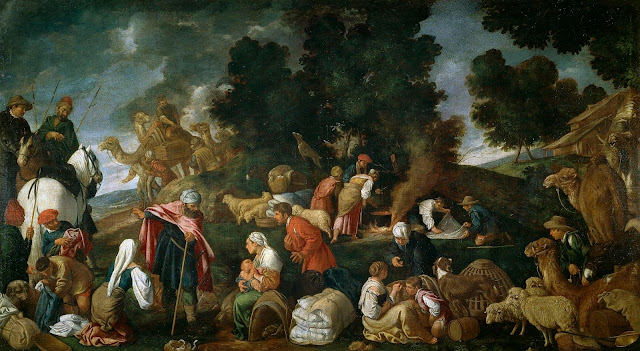 |
| Diego Velázquez Waterseller of Seville 1623 formerly in the Buen Retiro, currently in a London collection |
Having described picture-gathering in Italy and picture-gathering in the Flemish territories, Jonathan Brown and J.H. Elliott continue their account of Spanish royal picture-gathering of the 1630s. Quotations below are from A Palace for a King : The Buen Retiro and the Court of Philip IV (New Haven : Yale University Press, 1980) –
"The third and final source of pictures by contemporary artists was of course Madrid. The decoration of the Retiro provided an opportunity for Spanish court painters unequaled in the seventeenth century. To some extent, the opportunity outran the ability of the available talent. There was, however, one painter of genius on hand: Velázquez. ... In addition to commissioned works, there were paintings done by Velázquez earlier in his career. Besides the two important pictures painted in Italy in 1630, the Forge of Vulcan and Joseph's Bloody Coat Brought to Jacob (below), there was also his most famous early work, The Waterseller of Seville (above), which was probably a gift of the Cardinal-Infante, its third documented owner."
 |
| Diego Velázquez Forge of Vulcan c. 1630 Prado |
 |
| Diego Velázquez Joseph's Bloody Coat Brought to Jacob c. 1630 Monasterio de San Lorenzo, El Escorial |
"At the court, Velázquez worked in isolation from his senior colleagues, the now old-fashioned Vicente Carducho and Eugenio Cajés, who were still practicing an Italianate style they had learned forty years earlier. But these artists through their long years of royal service had earned the right to participate in the decoration of the Retiro."
 |
| Vicente Carducho Santa Inés 1637 Prado |
 |
| Vicente Carducho Adolphus, Gothic King 1634-35 Prado |
"The presence of the older generation of Spanish painters at the Retiro was even more emphatically asserted by Pedro de Orrente, a painter born in Murcia in 1580, who had probably worked in the Bassano family atelier in Venice. On his return to Spain, Orrente specialized in Bassanesque paintings of rustic Old and New Testament scenes set in extensive landscapes long after the tradition had died out in Italy."
 |
| Pedro de Orrente Laban Overtaking Jacob c. 1620-25 Prado |
 |
| Pedro de Orrente Abraham & Isaac 1630s Prado |
"The younger generation of painters in Madrid included several fine artists, but none of them could approach the originality or modernity of Velázquez. Félix Castelo and Jusepe Leonardo were both content to follow the example of their masters Carducho and Cajés."
 |
| Félix Castelo Theodoric, Gothic King 1635 Prado |
 |
| Jusepe Leonardo Alaric, Gothic King 1635 Prado |
"A more adventurous painter was Francesco Collantes, one of the rare Spanish landscape specialists of the seventeenth century. Collantes, born in 1599, the same year as Velázquez, is given as the author of twenty-two paintings in the 1701 inventory, almost all of which are landscapes. Working in the vein of late sixteenth-century Flemish landscape specialists, Collantes produced tranquil, limpid scenes of imaginary nature, populated by small foreground figures. All his identifiable works were installed in the private quarters."
 |
| Francisco Collantes Landscape with Crucifixion of Peter 1630s Prado |
 |
| Francisco Collantes Landscape with Adoration of the Shepherds 1630s Prado |
 |
| Francisco Collantes Landscape 1630s Prado |
"The youngest painter to participate in the decoration of the Retiro was Antonio de Pereda, who had been born in Valladolid in 1611. His appearance on the scene was the result of the patronage of Crescenzi. Pereda's moment in the limelight was brief, ending with the death of his patron in 1635. The failure to secure his position was unfortunate, for his considerable talent seldom found a suitable outlet thereafter."
 |
| Antonio de Pereda Immaculate Conception 1630s Prado |
 |
| Antonio de Pereda Annunciation 1630s Prado |